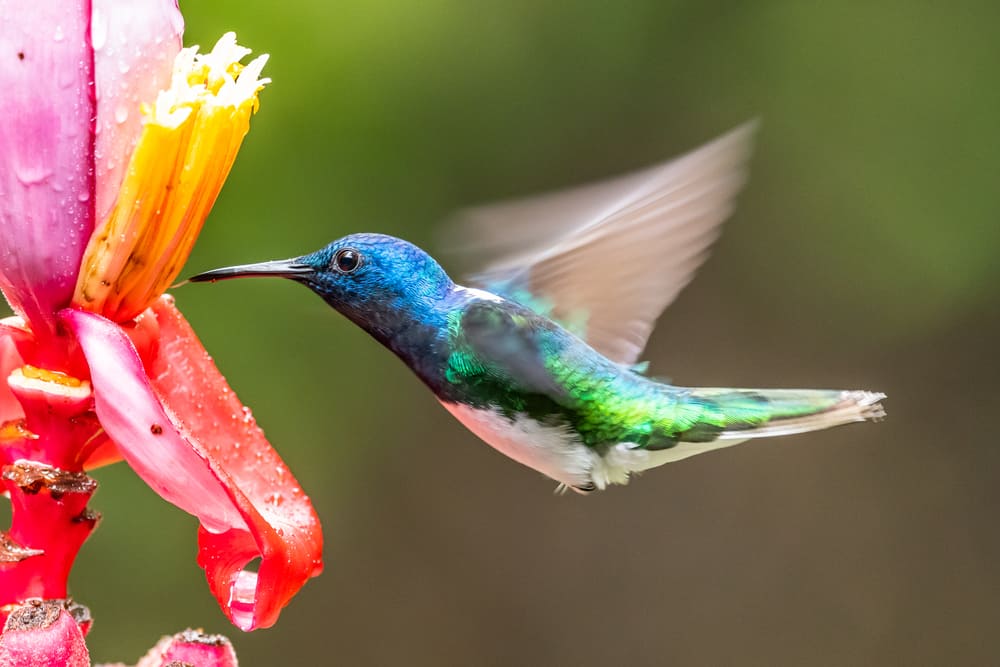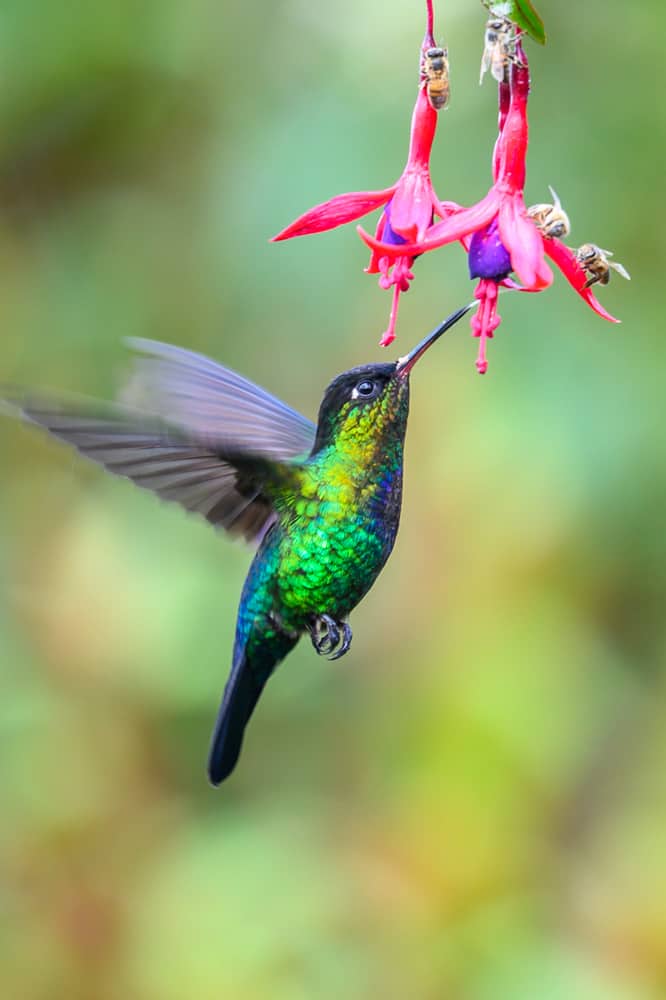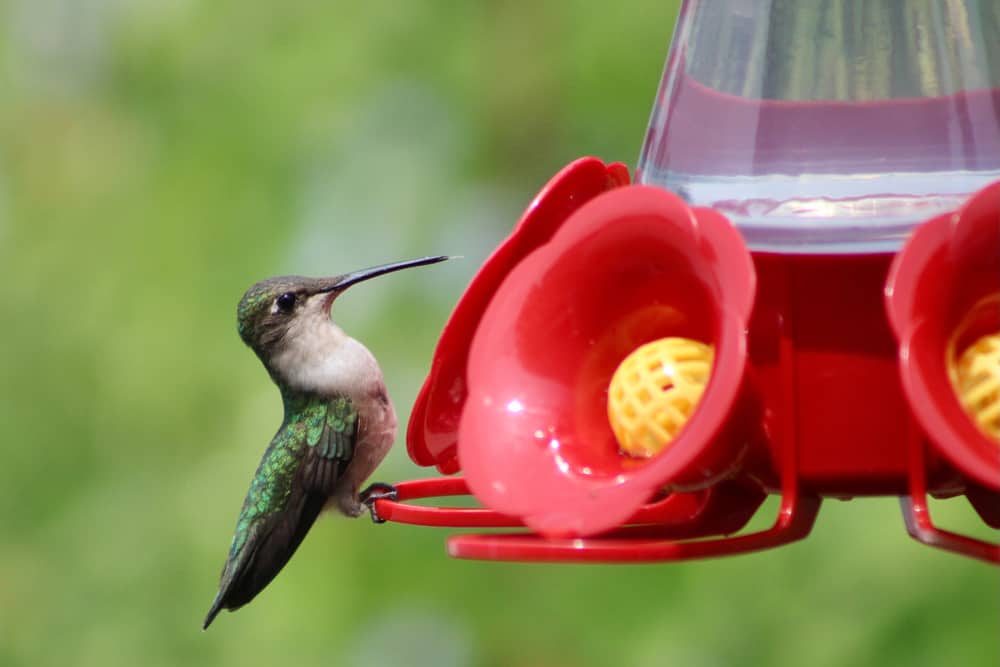Hummingbirds are native birds of the US. You can find around 360 species, but all of them have recognizable long, needle-shaped beaks. Almost everyone who has spent some time in nature knows that Hummingbirds eat nectar from flowers, but the question is, what do Hummingbirds eat besides nectar. Let’s see.
Hummingbird Habits and Biology
Physical characteristics are the ones that define Hummingbirds, and almost everyone that knows anything about birds will quickly recognize this species by their appearance. Plus, their wings make a unique sound while they fly through the air.
The Hummingbird’s small size is the first thing to recognize. As you have probably known, the title of the smallest bird worldwide belongs to Bee Hummingbird living in Cuba. Even though there are also a few larger and more vigorous species, they are still pretty small compared to other birds.
Interestingly, Hummingbirds differ from every other bird, but all Hummingbird species are pretty similar, including unique body shapes. They have long wings for these tiny bodies and long and narrow bills as their primary traits.
Their beaks have needle-like-looking tubes that allow sucking and licking nectar from fruits. Inside them are long tongues that help this process.
Unusually long wings enable these cuties to be incredibly agile in the air. In fact, the internal structure of those wings is more important than their shape.
Elbow and shoulder joints are very close, allowing them to tilt and independently move each wing. Thanks to this wing formation, Hummingbirds can change their direction fast and move while in the air.
Hummingbird types |
|
| Scientific classification | Hummingbirds |
| Kingdom | Animalia |
| Phylum | Chordata |
| Class | Aves |
| Order | Apodiformes |
| Family | Trochilidae |
| Subfamily | Trochilinae |
| Genus | Archilochus |
Do Hummingbirds Eat Dirt?
Different Hummingbirds types can sometimes stick their bills into sand, ashes, and seawater under specific conditions. You can sometimes see these tiny birds eating them and be confused about why they do such a thing. Well, all these materials are high in calcium and often contain sodium and other valuable minerals.
A group of scientists who tried to define the reason for such an unusual taste found out that primarily female Hummingbirds consume sand and ashes. It is their way to increase calcium levels in their bodies since they often lose lots of this mineral during egg production.
What Do Hummingbirds Like to Eat Most?
Seeing Hummingbirds fly from flower to flower while looking for nectar is expected, but spotting them eat something else can be confusing. However, anyone with experience or knowledge in ornithology can tell you that these birds like eating many things besides flower nectar.
Tree sap
The first records of Hummingbirds drinking tree sap dates back to the 1880s. Commonly, these birds like drinking tree sap as the perfect alternative to fruit nectar. The truth is that both tree sap and nectar contain a similar ratio of necessary sucrose, water, and amino acids.
Along these lines, Hummingbirds and Sapsuckers have a close relationship. It is likely that Ruby-throated and Rufous Hummingbirds travel northward and try to follow Sapsuckers.
In Canada and the northern US, these birds show up on settling grounds almost half a month before any flowers blossom and need to wait for nectar. Therefore, they secure all the energy they need from the sap while waiting.
Fruits
Many ripe and juicy fruits will attract Hummingbirds. If apples, berries, oranges, or pears are slightly open, birds will discreetly drink juices from them. One may expect they just follow bugs drawn to these natural products, yet some records show that this is not the case.
In 1894, Janet L. Hine wrote an article about Ruby-throat Hummingbirds. She mentioned a Hummingbird that came to the neighbor’s orchard and started sucking the juice from an apple. The weird thing was that the bird did that while a young girl tried to pare it.
Hummingbirds are additionally prepared to sip the juice of over-ready or recently made organic products. Nowadays, you can read about Hummingbirds that enjoy sucking juice made of different natural products. In most cases, pears, oranges, and prickly pears juices will attract these tiny birds.
Insects
Many small insects, insect larvae, insect eggs, and even spiders can find their place in Hummingbird’s diets. These birds consume bugs because they are excellent fat and protein sources necessary for their health. Hatchlings particularly need those proteins because they grow fast and can’t get essential nutrients from fruit and nectar.
Hummingbirds have developed many ways of hunting insects. They can do it by gleaning bugs from the flowers and leaves surfaces. Sometimes, they even collect insects up from spider nets or other sticky surfaces.
Remember that Hummingbirds need to eat several dozens of insects to get enough protein and fat for a healthy life. However, they will need to eat even more if they feed hatchlings or are in the middle of a long migration.
Pollen
Those lovely birds won’t eat pollen directly. However, the big part of this substance will surely stick to their tongues and bills while consuming nectar from flowers.
That indirectly eaten pollen will also provide necessary proteins and vitamins. Unfortunately, Hummingbirds can digest less than 10% of it, so you can conclude that it is not a common food source for them.
Food to Avoid Feeding Hummingbirds
In a period of the year when the natural nectar supply becomes low, the good idea is to place feeders in your backyard. Fill them with a proper sugar solution to imitate a natural nectar source.
It is pretty simple to feed Hummingbirds properly, but it is much easier to mess something up. The nectar you can provide is very simple to prepare, and the recipe closest to the sucrose levels in flowers these birds like the best includes four parts water and one part sugar.
However, be aware that only one simple ingredient can change it all. For instance, incorrect water to sugar proportion can be problematic. Overly weak nectar won’t attract Hummingbirds because it is too different from the natural one. On the other hand, too strong nectar will ferment more quickly and clog feeders.
Finally, some of those artificial sweeteners can be dangerous to hummingbirds, so you shouldn’t use them at all.
You should also be aware that your little visitors need a natural nectar source besides the artificial one you provide for them. Planting plants attractive to birds will help you in feeding them, and they will really enjoy it.
Artificial feeding methods during colder months always include feeders. The problem is that nectar can sometimes freeze inside these constructions when the temperatures are too low. Therefore, it is necessary to check them regularly and solve this problem as soon as it occurs.
There is one more issue. Sugar water is not only attractive to Hummingbirds, but ants, wasps, bees, hornets, and other insects also find it attractive. Keep in mind that some of those insects can sting and can be dangerous to these tiny birds.
Tips to Feed Hummingbirds
The best time to start feeding Hummingbirds can significantly vary. It usually depends on many factors, including local climates, weather, and migrations.
Therefore, you should track all those parameters and learn helpful tricks to attract these sweet birds into your yard. If you expect Hummingbirds to show soon, it is time to put feeders outside and wait for the first migrants to come and start enjoying.
It is crucial to know what type of fruit and flowers will attract Hummingbirds. That knowledge will help you arrange your backyard properly as a feeding station for many of these birds.
Almost every region worldwide has a native flora, including areas where Hummingbirds live. Therefore, planting flowers and shrubs that produce lots of blooms rich in nectar is always an excellent idea to attract these birds. The best ones include:
- Honeysuckle
- Coral bells
- Red tubular flowers
Always try to equip your backyard with many different plants that bloom throughout the season and provide enough nectar for Hummingbirds. As you can guess, it is also crucial to avoid plants these birds don’t like.
The next thing to keep in mind is to avoid using insecticides. They are usually toxic to birds, plus they are not necessary in this case. Hummingbirds will eat most bugs efficiently. Also, give your best to avoid pesticides in your backyard because they can harm those lovely birds.
Never clean spider nets from corners to help Hummingbirds in feeding. Insects will stick to those nets, and birds will quickly eat them.
Always take proper care of feeders and their condition. Dirty feeders often contain bacteria toxic to Hummingbirds. You can be sure that Hummingbirds won’t use them if there are dead insects around. Therefore, always clean and sterilize them timely and adequately.
In the end, even the feeder color is crucial. For instance, red feeders are conspicuous, and they will attract Hummingbirds immediately.
Summary
Hummingbirds can quickly find their natural nectar source somewhere in nature. If you have some of those sources in your backyard, you can make their job easier. In that situation, both sides will win. Hummingbirds will get an affordable source of natural nectar, while you can enjoy watching those beautiful little birds at any time.


